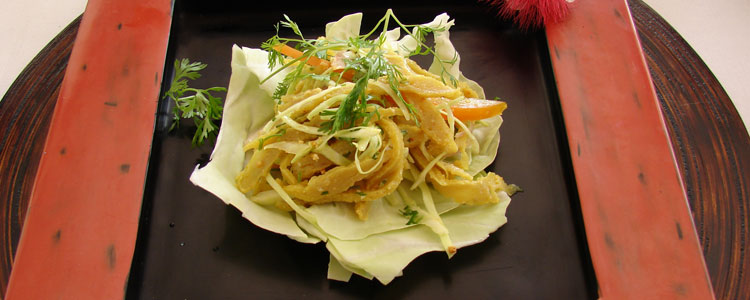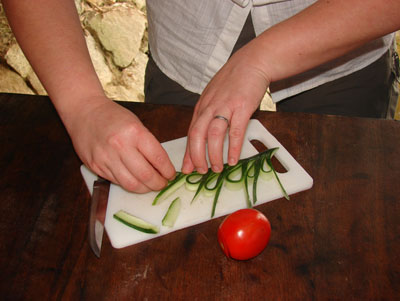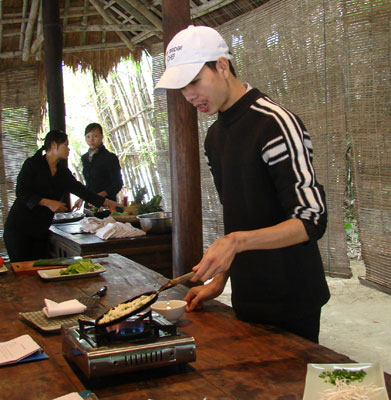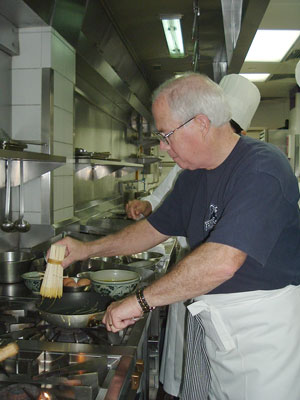It's all about the food — Cooking classes in Asia
by Sandra Scott, Mexico, NY
I love serving my dinner guests Phad Thai and hearing them ask, “Where did you learn to make Phad Thai?”
I enjoy their surprised looks when I reply, “At the Peninsula Hotel in Bangkok.”
A cooking class is a delicious and personal way to learn about a country and its culture. Thanks to the popularity of TV cooking shows, hotels and restaurants worldwide offer a variety of cooking experiences. The lessons vary from demonstrations to hands-on cooking. A few are free, but most cost between $18 and $200.
On our 3-month trip in Asia, January through March ’08, my husband, John, and I took several cooking lessons. Each was unique, but all were wonderful — and delicious.
The Philippines
The village of Lucban was the first stop on our daylong culinary tour ($60 per person) of Quezon Province, booked through the Department of Tourism (www.wowphilippines.com.ph).
As she prepared colorful rice paper wafers, Milada Valde explained, “We start in April making thousands of kiping. On May 15 we give thanks to San Isidro Labrador for a good harvest by covering our houses in fruits, vegetables and kiping. If we cook the kiping, we can eat it, too.”
The kipings are fashioned into flowers, chandeliers and other decorative items. While the kipings were drying, she demonstrated how generations of her family have been making the town’s other local delicacy, Lucban Longganisa, a type of sausage.
Vietnam
In the historic city of Hoi An, Chef Thanh pointed to the large mirror above his cooking demonstration table and quipped, “Vietnamese TV.”
Our international group of 20 had arrived at the Red Bridge Cooking School (phone 84 510 933222, www.visithoian.com/redbridge.html) via a 25-minute scenic boat ride on the Hoi An River. After each demonstration, the chef ordered, “Now you try. If you don’t do it right, do it again — at home!”
Each participant had their own gas burner with all the necessary ingredients laid out by the staff. Chef Thanh’s quick wit and snappy patter made me wonder if he were practicing for a spot on the cooking channel.
We learned to prepare a complete Vietnamese meal, including how to make Hoi An pancakes and food decorations. I will need more practice to make attractive food decorations. Chef Thanh’s advice — “If you make a mistake, eat it!”
Our half-day lesson (8:00-2:30) cost $18 per person — a “do not miss!”
Hu˜e was the Imperial City during the 19th century and emerged as the culinary capital of Vietnam. And no wonder! Legend has it that the finicky emperors demanded something different for every meal.
At La Résidence Hotel (phone +84 054 3837475, www.la-residence-hue.com), we climbed into a cyclo for a trip to the city’s market to get the fresh ingredients for our cooking lesson, which cost $25. We passed on the option to leave at 5 a.m. to visit a place where they make rice noodles very early each morning.
Returning to the hotel’s Le Parfum restaurant, with its view of the Imperial City across the river, we learned how to make one of my favorite recipes, sautéed chicken with lemongrass, ginger and chili.
Myanmar
In Yangon, our cooking class ($50) started with a tour of the outdoor market led by Mr. Ko Ko, the restaurant manager at The Governor’s Residence (from the US, phone 800/237-1236, www.governorsresidence.com). It quickly became a cultural tour.
Mr. Ko Ko picked up a piece of bark, saying, “This is not food. This is thanaka. The women grind it into a powder and apply it to their face to protect it from sun.”
At a stall selling longyis, the traditional sarong-style garb worn by most adults in Myanmar, Mr. Ko Ko asked, “Do you know the proper way to wear a longyi?” Unwrapping his longyi, he explained, “The men fold it like this in the front with a twist knot. The women secure it on the side.”
We purchased featherback fish to make fish cake salad and returned to the hotel in a 1940s mini-truck. After our lesson, which took place on the hotel’s expansive second-floor teak veranda, we savored the finished product while enjoying the view of the tropical garden.
The Princess Resort (phone +00 95 81 29055, www.inleprincessresort.com), at Lake Inle, is the perfect setting for their “Cooking Experience in an Inthar House” program ($30).
The morning started with shopping in one of the local 5-day markets, where we bargained for and bought the ingredients needed for the recipes. The next stop was a local Inthar house, the home of one of the resort’s staff, where the staff member was waiting to teach Inthar-style cooking. Sharing the finished meal with the family was a wonderful way to bridge the cultural gap.
Bangkok, Thailand
“Good morning! Here is your chilled bottle of water. The Sam Yan wet market is only 15 minutes away,” said the liveried driver of the Peninsula’s Mercedes. So began our lesson on how to make Phad Thai with an egg net.
On the guided tour of the wet market, we learned about red-skinned dragon fruit and black-skinned chicken. It quickly became obvious why it is called a “wet market”; vendors were constantly spraying their produce to keep it fresh looking.
Back at the gleaming, stainless-steel kitchen of the Peninsula (866/382-8388, www.peninsula.com), we learned how to make Phad Thai and an egg net. An egg net is so easy to make that we use it for making hors d’oeuvres, placing julienned meat and/or veggies on the egg net and rolling them up like spring rolls.
The per-person cost ($200) included the guided market tour, private cooking lesson and meal.
Every time I have lemongrass, it conjures up images of Myanmar. When eating Thai food I recall our relaxing days in Thailand. I have a new appreciation of food decorations after my inept attempts to make some in Vietnam. And on May 15th I think of the kiping-covered houses in Lucban.
Cooking lessons are a great way to savor travel and keep the memory of the trip fresh every time one of the recipes is prepared.




